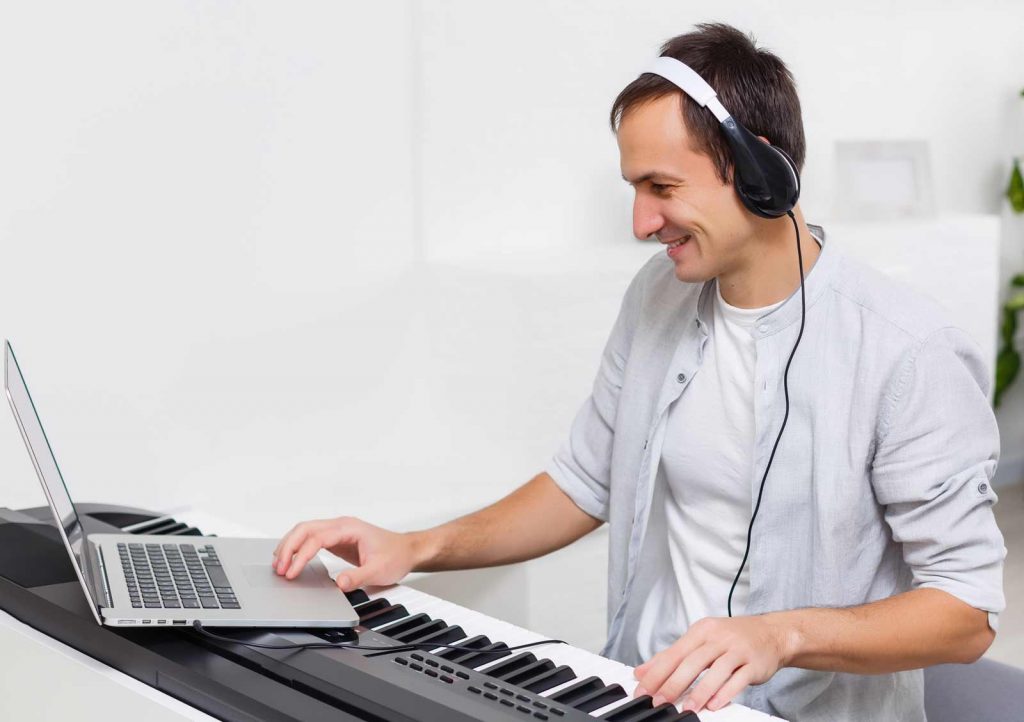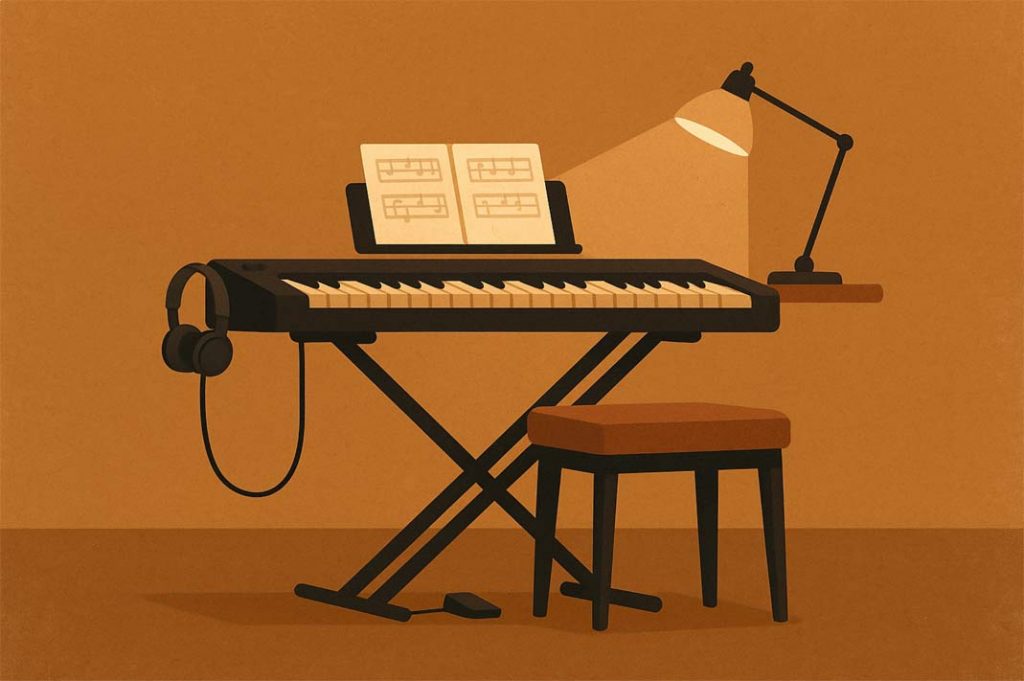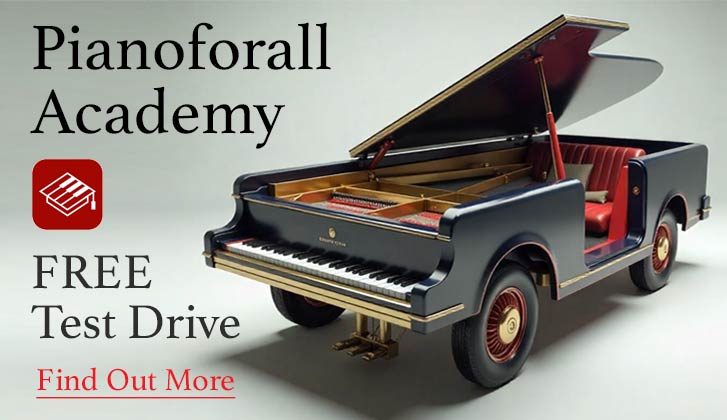Can You Really Learn Piano Online as a Complete Beginner?
Absolutely! If you can listen and follow shapes and patterns, you can learn piano online. You can never be “too old,” and you don’t need special talent. What you need is a clear path, short lessons you can practice repeatedly, and a method that lets you sound good early on so you stay motivated. The first step is learning a few simple chords so you can make real music right away.
The First Step: Chords
Why start with chords? Chords are the building blocks of all music. If you learn a few shapes and a few simple rhythms, and you can play hundreds of tunes—like a guitarist who starts with a handful of chords and a simple strum.
Check out this video from Pianoforall which explains how to get started using chords.
This simple progression already sounds like real music. From here, Pianoforall takes a few easy chords and shows you the most common “rhythms” (ways to move your hands) used in nearly all popular songs. Once you can keep one pattern steady, you add small embellishments step by step so your playing sounds finished without getting complicated.
From there you’ll dip a toe into blues and jazz patterns and a little improvisation (just a few notes that fit each chord). Understanding chords also makes classical pieces easier — chords are often at the heart of patterns or melodies, so you can remember the chord shapes rather than memorising hundreds of individual notes.
The trailer video below shows a few of these rhythms in action.
Online vs Private Lessons: Which Is Better?
If you enjoy in‑person accountability and real‑time feedback, a private teacher is excellent. If you need flexibility, lower cost, and the ability to replay lessons, online learning can be ideal. Many adults choose online first, then add an occasional lesson later for feedback. If you learn piano online, the next choice is between random YouTube videos and a structured curriculum.
Private Lessons
- Pros: real‑time feedback, accountability, personalised corrections.
- Cons: higher ongoing cost, fixed schedule, most likely traditional teaching methods.
Online Courses
- Pros: flexible, affordable, replay anytime, learn piano online in short bursts at home at your own pace.
- Cons: requires self‑management; choose a proper curriculum (not random videos).
Is YouTube Enough?
YouTube is great for tips and inspiration, but it can never be as effective as a step‑by‑step course. Random lessons often skip foundations or teach specific songs without the skills underneath. That leads to gaps and frustration. A structured curriculum gives you sequence, practice targets, and layered skills (rhythm, chords, ear, reading) that build together.
How to Choose an Online Course
Beginner‑proof checklist
- Short, replayable lessons
- Clear, step‑by‑step path (not random tutorials)
- Real songs from the start so you sound musical quickly
- On‑screen diagrams and slow demos
- A method that combines playing by ear and learning to read (gradually)
- Practice targets for each step
- Support/Community/Q&A when stuck
- Lifetime access so you can review anytime
Pianoforall was designed around those points, especially for adult beginners. Here’s why that matters in your first months.
Why Pianoforall Fits Beginners
- Chords first: you sound musical early, like learning guitar chords and strumming.
- Read as you go: notation comes in gently alongside playing by ear—no complicated theory.
- Rhythm style: pop, ballads, blues, and jazz patterns you can actually enjoy.
- Bite sized lessons + eBooks: easy to fit into busy days; review anytime.
- Support: ask questions in the course comments or via email.
- Community: Join thousands of students around the world for added support or just chat
With a course chosen, it helps to know how much time you’ll need and when you’ll start to sound good.
How Much Practice? How Long Until You Sound Good?
Practice time to plan for
- Weeks 1–4: 15–20 minutes a day, 5 days a week.
- After Month 1: 20–30+ minutes a day, 5–6 days a week.
Typical milestones
- 2–4 weeks: steady rhythm style chord progressions; recognisable tunes.
- 6–12 weeks: smoother left hand, broken‑chord right hand, simple arrangements.
- 3–6 months: comfortable playing for friends at a relaxed tempo.
- 6–12 months: a small repertoire plus light improvisation.
Do You Need to Read Music?
No, not at the start. Playing by ear builds your sound and timing. Reading music is added in small steps—like the way we learned to read as children after learning to speak first.
What You’ll Learn in Your First Months
- 10–15 essential chords and smooth changes between them
- Left‑hand patterns that make songs “groove”
- Right‑hand broken chords, fills, and simple melodies
- Learn complete songs (intro, verse/chorus loop, ending)
- A safe way to improvise with a small set of notes
- Reading basics (note landmarks and simple rhythms)
- How to practise so things stick
Your step-by-step path
Start sounding good fast, then expand into blues, jazz, improv and smart reading.
Chords + essential rhythm patterns; steady left hand.
Broken-chord left hand, fills and melody in the right.
12-bar blues, riffs, recognisable rhythms, turnarounds.
Easy voicings, extensions, how to improvise.
Safe note sets, call-and-response.
Note landmarks, rhythm basics, applied reading.
See what’s included →
| Prefer classical?
Satie ·
Bach ·
Moonlight
How Long to Become Proficient?
With 20–30 minutes most days, many adults reach comfortable, versatile playing in 6–12 months. If you already play another instrument, it may be quicker; if life is busy, slower is fine. Consistency wins.
Before you begin, set yourself up with the right keyboard and a simple, comfortable practice corner.
Keyboard or Piano? What to Buy
Beginner keyboard setup (quick checklist)
- Keys: 61+ full-size (76 better, 88 best)
- Touch sensitivity: non-negotiable
- Action: semi-weighted or weighted if possible
- Sustain Pedal: must have an input – and match the keyboard
- Ergonomics: stable stand & height-adjustable seat
- Connectivity: headphones; ideally USB-MIDI
Do you need lots of keyboard functions?
No. Hundreds of sounds and built‑in rhythms are optional. Good key feel and authentic piano sound matter most. But it can be fun to play along with built in rhythms.
Digital vs acoustic piano
A decent digital piano is perfect for learning at home: consistent sound, headphones, and no tuning costs.
Not sure what to buy yet? Read our plain-English keyboard buying guide.
How to Sit and Set Up (Avoid Aches)
- Bench height: elbows near key height, wrists straight.
- Shoulders down, neck relaxed. Breaks: 30–60 seconds every 5–7 minutes at first.
- Leave your keyboard ready to play—reducing friction makes daily practice easier.
Early Discomfort Is Normal
New movements can feel strange. Light wrist or back fatigue can happen in the first weeks. Keep your practice sessions short, stay relaxed, and stop if pain persists. Small, regular practice is better than marathon sessions.
If you had lessons years ago, some familiarity may return, but you don’t need that background to succeed now.
If You Had Lessons as a Child
That can be useful but it’s not required. Adults often progress faster because they can focus and practise on purpose.
And if you’re worried you lack “talent,” here’s the truth.
“I Have Zero Talent” (You Don’t Need It)
Skill comes from small steps repeated. If you can count to four and move your fingers, you can learn chords and rhythm. Progress may feel slow at first; that’s normal.
To keep yourself on track, these essentials make online learning smoother.
10 Essentials for Learning Piano Online
- Short daily practice (15–25 minutes) beats long, rare sessions.
- Start with chords and rhythm; add melody later.
- Go slow. Clean repetitions before speed.
- Practise two bars at a time (“micro‑loops”).
- Record yourself and listen to it to see where you can improve
- Keep gear simple: good keys + sustain pedal + headphones.
- Learn a few endings and fills—instant polish.
- Be patient with yourself – it will take time for it all to click
- Follow a structured path; avoid random video hopping.
Besides enjoyment, adults often ask about benefits for concentration and mood. Here’s a measured view.
Learning Later in Life: Focus and Mood
Learning an instrument engages hearing, movement, memory, and attention at the same time. Many adults report better focus and mood. Some research suggests instrument training can support thinking skills, though results vary. Treat it as a healthy habit with musical rewards rather than a medical treatment.
Finally, a few common beginner questions—and your next step if you want to try it today.
Beginner FAQs
Am I too old to start?
No. Adults often learn faster than they expect because they can focus and practise regularly.
How much will I need to practise?
Start with 15–20 minutes a day, 5 days a week. Increase to 20–30 minutes as it gets easier.
How quickly will I be able to play for friends?
Often within 2–3 months at a relaxed tempo, if you follow a chord‑first method and practise steadily.
Do I need to read music?
Not at the start. You can learn by ear and add reading gradually.
Is 61 keys enough?
It can work briefly. 88 keys (full size) are strongly recommended for long‑term progress.
What about subscriptions?
Subscriptions can work, but a one‑time course with lifetime access removes pressure and lets you learn at your pace.
Do I get help if I’m stuck?
Yes. Use the course Q&A/comments or email to ask questions. You can also share a short clip to describe an issue.
Next Steps
- Try a free lesson and sample eBook: Free Test Drive.
- When ready, start here: Pianoforall: Learn Piano by Ear.
- Prefer classical pieces taught by ear? Satie • Bach Preludes • Moonlight Sonata (1st Mvt)
Blogger, teacher, or creator? Partner with us.
Can You Really Learn Piano Online as a Complete Beginner?
Yes. If you can listen and press a key, you can learn piano online. You are not “too old,” and you don’t need special talent. What you need is a clear path, short lessons you can repeat, and a method that lets you sound good early so you stay motivated. The first step is learning a few simple chords so you can make real music right away.
“It’s the only piano course I recommend to my students.” — Brian Kelly, zombieguitar.com •
“Within an hour, I was making music.” — JD Loveland
Your First Step: Chords
Why start with chords? They’re the building blocks of all music. Learn a few shapes and a steady count, and you can play hundreds of tunes—like a guitarist who starts with a handful of chords and a simple strum.
Check out this video from Pianoforall which explains how to get started using chords.
This simple loop already sounds like real music. From here, Pianoforall takes a few easy chords and shows you the most common “rhythms” (ways to move your hands) used in nearly all popular songs. Once you can keep one pattern steady, you add small embellishments step by step so your playing sounds finished without getting complicated.
From there you’ll dip a toe into blues and jazz patterns and a little improvisation (just a few notes that fit each chord). Understanding chords also makes classical pieces easier — the right hand often breaks a chord into a flowing pattern while the left holds the harmony, so you learn it step by step instead of memorising hundreds of single notes.
The trailer video below shows a few of these rhythms in action.
Online vs Private Lessons: Which Is Better?
If you enjoy in‑person accountability and real‑time feedback, a private teacher is excellent. If you need flexibility, lower cost, and the ability to replay lessons, online learning can be ideal. Many adults choose online first, then add an occasional lesson later for feedback. If you learn piano online, the next choice is between random YouTube videos and a structured curriculum.
Private Lessons
- Pros: real‑time feedback, accountability, personalised corrections.
- Cons: higher ongoing cost, fixed schedule, less replay.
Online Courses
- Pros: flexible, affordable, replay anytime, learn piano online in short bursts at home.
- Cons: requires self‑management; choose a proper curriculum (not random videos).
Is YouTube Enough?
YouTube is great for tips and inspiration, but it isn’t a step‑by‑step course. Random lessons often skip foundations or teach specific songs without the skills underneath. That leads to gaps and frustration. A structured curriculum gives you sequence, practice targets, and layered skills (rhythm, chords, ear, reading) that build together.
How to Choose an Online Course
Beginner‑proof checklist
- Short, replayable lessons
- Clear, step‑by‑step path (not random uploads)
- Early wins so you sound musical quickly
- On‑screen diagrams and slow demos
- Method that combines playing by ear and learning to read (gradually)
- Practice targets for each step
- Support/Community/Q&A when stuck
- Lifetime access so you can review anytime
Pianoforall was designed around those points, especially for adult beginners. Here’s why that matters in your first months.
Why Pianoforall Fits Beginners
- Chords first: you sound musical early, like learning guitar chords and strumming.
- Read as you go: notation comes in gently alongside playing—no complicated theory.
- Rhythm style: pop, ballads, blues, and jazz patterns you can actually use.
- Small lessons + eBooks: easy to fit into busy days; review anytime.
- Support: ask questions in the course comments or via email.
- Community: Join thousands of students around the world for added support or just chat
With a course chosen, it helps to know how much time you’ll need and when you’ll start to sound good.
How Much Practice? How Long Until You Sound Good?
Practice time to plan for
- Weeks 1–4: 15–20 minutes a day, 5 days a week.
- After Month 1: 20–30+ minutes a day, 5–6 days a week.
Typical milestones
- 2–4 weeks: steady rhythm style chord loops; friends recognise a tune.
- 6–12 weeks: smoother left hand, broken‑chord right hand, simple arrangements.
- 3–6 months: comfortable playing for friends at a relaxed tempo.
- 6–12 months: a small repertoire plus light improvisation.
Do You Need to Read Music?
No, not at the start. Playing by ear builds your sound and timing. Reading is added in small steps—like the way we learned to read as children after learning to speak first.
What You’ll Learn in Your First Months
- 10–15 essential chords and smooth changes between them
- Left‑hand patterns that make songs “groove”
- Right‑hand broken chords, fills, and simple melodies
- Learn complete songs (intro, verse/chorus loop, ending)
- A safe way to improvise with a small set of notes
- Reading basics (note landmarks and simple rhythms)
- How to practise so things stick
Your step-by-step path
Start sounding good fast, then expand into blues, jazz, improv and smart reading.
Chords + essential rhythm patterns; steady left hand.
Broken-chord left hand, fills and melody in the right.
12-bar blues, riffs, recognisable rhythms, turnarounds.
Easy voicings, extensions, how to improvise.
Safe note sets, call-and-response.
Note landmarks, rhythm basics, applied reading.
See what’s included →
| Prefer classical?
Satie ·
Bach ·
Moonlight
How Long to Become Proficient?
With 20–30 minutes most days, many adults reach comfortable, versatile playing in 6–12 months. If you already play another instrument, it may be quicker; if life is busy, slower is fine. Consistency wins.
Before you begin, set yourself up with the right keyboard and a simple, comfortable practice corner.
Keyboard or Piano? What to Buy
Beginner keyboard setup (quick checklist)
- Keys: 61+ full-size (76 better, 88 best)
- Touch sensitivity: non-negotiable
- Action: semi-weighted or weighted if possible
- Sustain Pedal: must have an input – and match the keyboard
- Ergonomics: stable stand & height-adjustable seat
- Connectivity: headphones; ideally USB-MIDI
Do you need “bells and whistles”?
No. Hundreds of sounds and built‑in rhythms are optional. Good key feel and authentic piano sound matter most.
Digital vs acoustic piano
A decent digital piano is perfect for learning at home: consistent sound, headphones, and no tuning costs.
Not sure what to buy yet? Read our plain-English keyboard buying guide.
How to Sit and Set Up (Avoid Aches)
- Bench height: elbows near key height, wrists straight.
- Shoulders down, neck relaxed. Breaks: 30–60 seconds every 5–7 minutes at first.
- Leave your keyboard ready to play—reducing friction makes daily practice easier.
Early Discomfort Is Normal
New movements can feel strange. Light wrist or back fatigue can happen in the first weeks. Keep sessions short, stay relaxed, and stop if pain persists. Small, regular practice is better than marathon sessions.
If you had lessons years ago, some familiarity may return, but you don’t need that background to succeed now.
If You Had Lessons as a Child
Useful but not required. Adults often progress faster because they can focus and practise on purpose.
And if you’re worried you lack “talent,” here’s the truth.
“I Have Zero Talent” (You Don’t Need It)
Skill comes from small steps repeated. If you can count to four and move your fingers, you can learn chords and rhythm. Progress may feel slow at first; that’s normal.
To keep yourself on track, these essentials make online learning smoother.
10 Essentials for Learning Piano Online
- Short daily practice (15–25 minutes) beats long, rare sessions.
- Start with chords and rhythm; add melody next.
- Go slow. Clean repetitions before speed.
- Practise two bars at a time (“micro‑loops”).
- Use a tempo ladder: 50 → 60 → 72 → 84 bpm.
- Record yourself for 20 seconds; listen back once.
- Keep gear simple: good keys + sustain pedal + headphones.
- Learn a few endings and fills—instant polish.
- Be patient with your left hand; groove lives there.
- Follow a structured path; avoid random video hopping.
Besides enjoyment, adults often ask about benefits for concentration and mood. Here’s a measured view.
Learning Later in Life: Focus and Mood
Learning an instrument engages hearing, movement, memory, and attention at the same time. Many adults report better focus and mood. Some research suggests instrument training can support thinking skills, though results vary. Treat it as a healthy habit with musical rewards rather than a medical treatment.
Finally, a few common beginner questions—and your next step if you want to try it today.
Beginner FAQs
Am I too old to start?
No. Adults often learn faster than they expect because they can focus and practise regularly.
How much will I need to practise?
Start with 15–20 minutes a day, 5 days a week. Increase to 20–30 minutes as it gets easier.
How quickly will I be able to play for friends?
Often within 2–3 months at a relaxed tempo, if you follow a chord‑first method and practise steadily.
Do I need to read music?
Not at the start. You can learn by ear and add reading gradually.
Is 61 keys enough?
It can work briefly. 88 keys (full size) are strongly recommended for long‑term progress.
What about subscriptions?
Subscriptions can work, but a one‑time course with lifetime access removes pressure and lets you learn at your pace.
Do I get help if I’m stuck?
Yes. Use the course Q&A/comments or email to ask questions. You can also share a short clip to describe an issue.
Next Steps
- Try a free lesson and sample eBook: Free Test Drive.
- When ready, start here: Pianoforall: Learn Piano by Ear.
- Prefer classical pieces taught by ear? Satie • Bach Preludes • Moonlight Sonata (1st Mvt)
Blogger, teacher, or creator? Partner with us.






